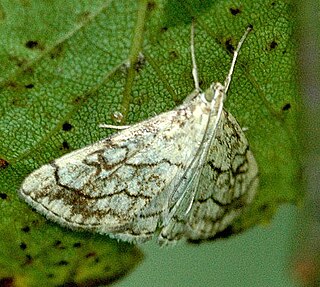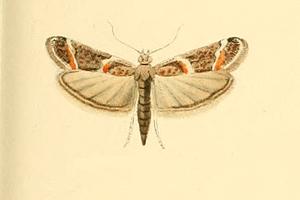
The Pyralidae, commonly called pyralid moths, snout moths or grass moths, are a family of Lepidoptera in the ditrysian superfamily Pyraloidea. In many classifications, the grass moths (Crambidae) are included in the Pyralidae as a subfamily, making the combined group one of the largest families in the Lepidoptera. The latest review by Eugene G. Munroe and Maria Alma Solis retain the Crambidae as a full family of Pyraloidea.

The Pyraloidea are a moth superfamily containing about 16,000 described species worldwide, and probably at least as many more remain to be described. They are generally fairly small moths, and as such, they have been traditionally associated with the paraphyletic Microlepidoptera.

Evergestinae is a fairly small subfamily of the lepidopteran family Crambidae, the crambid snout moths. The subfamily was described by H. Marion in 1952. It contains roughly 140 species on all continents and continental islands. Evergestine moths resemble Pyraustinae; however, the male genitalia have a long uncus and long, slender gnathos. The larvae feed mostly on Brassicaceae.

Spilomelinae is a very species-rich subfamily of the lepidopteran family Crambidae, the crambid snout moths. With 4,135 described species in 344 genera worldwide, it is the most speciose group among pyraloids.

In biological taxonomy, circumscription is the content of a taxon, that is, the delimitation of which subordinate taxa are parts of that taxon. For example, if we determine that species X, Y, and Z belong in genus A, and species T, U, V, and W belong in genus B, those are our circumscriptions of those two genera. Another systematist might determine that T, U, V, W, X, Y, and Z all belong in genus A. Agreement on circumscriptions is not governed by the Codes of Zoological or Botanical Nomenclature, and must be reached by scientific consensus.

Agrotera is a genus of snout moths in the subfamily Spilomelinae of the family Crambidae. It is the type genus of the tribe Agroterini and currently comprises 28 species distributed in the Afrotropical, Palearctic, Indomalayan and Australasian realm.

Mnesictena is a genus of snout moths in the subfamily Spilomelinae, where it is placed in the tribe Udeini. The genus was erected by the English entomologist Edward Meyrick in 1884. The currently known seven species are exclusively found on New Zealand and the associated Antipodes Islands and Chatham Islands.

Parapoynx fluctuosalis or Fluctuating China-mark or Waved China-mark, is a moth of the family Crambidae. It is a widespread species, known from Africa, India, Sri Lanka, China, Japan, Malaysia, Taiwan, Guam, Hawaii, Fiji, Australia and the Galápagos Islands. It is also an introduced species in Europe, where it has been recorded from Great Britain, the Iberian Peninsula and Sardinia.
Ambluncus is a monotypic snout moth genus described by Hans Georg Amsel in 1954. It contains the species Ambluncus nervosellus, described by Edward Meyrick in 1934. It has been recorded from the Canary Islands and the United Arab Emirates, and probably the rest of North Africa.

Ancylosis faustinella is a species of snout moth in the genus Ancylosis. It was described by Philipp Christoph Zeller, in 1867 from Palestine, but is also found on Malta and in Russia, as well as on the Canary Islands, in Algeria, Tunisia, Libya, Morocco, Egypt, Saudi Arabia, Yemen, Bahrain, Turkey, Afghanistan, Syria, Iran, Israel, Jordan, Lebanon, Mongolia, Pakistan, Niger and Sudan.
Ancylosis harmoniella is a species of snout moth in the genus Ancylosis. It was described by Émile Louis Ragonot, in 1887 from Spain, Malta, Turkey, Algeria, Morocco, Tunisia, Libya, Egypt, Saudi Arabia, the Palestinian Territories, Syria, Iraq, Iran, Afghanistan and Transcaucasia.

Ancylosis samaritanella is a species of snout moth in the genus Ancylosis. It was described by Zeller in 1867. It is found in Spain, Russia, Turkey, Jordan, the Canary Islands, Morocco, Algeria, Tunisia, Libya, Egypt, Sudan, Saudi Arabia, Turkestan and Central Asia.
Ancylosis nubeculella is a species of snout moth in the genus Ancylosis. It was described by Ragonot in 1887. It is found in Sudan, Saudi Arabia, Turkey, the southern Caucasus, Iran, Pakistan, Afghanistan, Egypt and the Canary Islands.

Isauria dilucidella is a species of moth in the family Pyralidae. It was described by Philogène Auguste Joseph Duponchel in 1836. It is found in most of Europe, Algeria, the United Arab Emirates, Syria, Lebanon, the Palestinian territories, Iraq, Turkmenistan, Mongolia, as well as Georgia, Kazakhstan, Armenia, Turkey, Iran and Afghanistan.
Thylacoptila paurosema is a species of moth of the family Pyralidae. It has a wide range and is found on the Canary Islands, Cabo Verde, Ethiopia, Ghana, Réunion, Saudi Arabia, Sierra Leone, Sudan, Namibia, South Africa, Yemen, Madagascar, Indonesia, Burma, Malaysia, Pakistan, Sri Lanka, India and Ascension Island.

Oxybia is a monotypic snout moth genus described by Hans Rebel in 1901. Its only species, Oxybia transversella, was described by Philogène Auguste Joseph Duponchel in 1836. It is found in southern Europe and on the Canary Islands.
Nephopterygia is a monotypic snout moth genus described by Hans Georg Amsel in 1965. Its only species, N. austeritella, described by the same author, is found on the Canary Islands, as well as in Sudan and Egypt.

Glaphyriinae is a subfamily of the lepidopteran family Crambidae. It was described by William Trowbridge Merrifield Forbes in 1923. The subfamily currently comprises 509 species in 75 genera.

Scopariinae is a subfamily of the lepidopteran family Crambidae. The subfamily was described by Achille Guenée in 1854.

Tawhitia pentadactylus is a moth in the family Crambidae. It was described by Zeller in 1863. It is found in Australia (Tasmania) and in New Zealand, where it has been recorded from South Island and the southern part of the North Island. The habitat consists of subalpine swamps.











